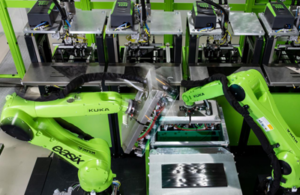Software based tape stacking with the aid of camera technology paves the way for thermoplastic composites
by Norbert Müller, Engel Austria, and Paul Zwicklhuber, Engel Center for Lightweight Composite Technologies
Thermoplastic tapes are expected to achieve great things, namely to shape the next generation of thermoplastic composites. This calls for highly accurate tape stacking. At the same time, tape processing must not become so complex that it becomes uneconomical. Engel contributes this technology to achieve a breakthrough by combining high precision control software with camera technology in tape stacking.
Melting and solidification are the central physical processes that characterize thermoplastic processing. These changes of state can occur in a comparatively short time. That is why thermoplastics processing methods have above average productivity. Composites are characterized by the use of long fibers; ideally continuous fibers. These confer extremely high rigidity and strength values combined with low component weight. Thermoplastic composites offer the best of both worlds: high process efficiency and outstanding lightweight design properties. That is precisely why they are so exciting for mass production of lightweight designs.

